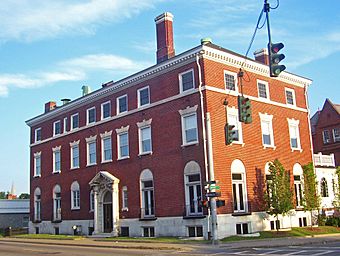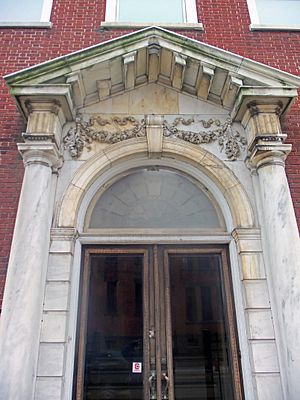Amrita Club facts for kids
Quick facts for kids |
|
|
Amrita Club
|
|

North (front) elevation and west profile, 2008
|
|
| Location | Poughkeepsie, NY |
|---|---|
| Built | 1912 |
| Architect | Alfred E. Barlow |
| Architectural style | Colonial Revival |
| MPS | Poughkeepsie MRA |
| NRHP reference No. | 82001119 |
| Added to NRHP | November 26, 1982 |
The Amrita Club building is a historic place in Poughkeepsie, New York. It stands at the corner of Church and Market streets. This building was once home to an important club for local businessmen and professionals.
In 1982, the Amrita Club building was added to the National Register of Historic Places (NRHP). This means it is recognized as a special place in American history. The building was constructed in 1912. It is one of only two brick buildings in Poughkeepsie built in the Colonial Revival style. Today, a software company called DTI uses the building as its main office.
What Does the Amrita Club Building Look Like?
The Amrita Club building is located in a very old and interesting part of Poughkeepsie. Many other historic buildings are nearby. For example, the Market Street Row and the Hasbrouck House are close by. The Adriance Memorial Library is also just a few houses away. Across the street, you can see the armory and the Old Poughkeepsie YMCA. All these buildings are also listed on the National Register of Historic Places.
The Amrita Club building is a rectangular shape. It has three stories and a raised basement. The front of the building has eight or nine sections, called bays, and it is three sections deep.
The main entrance is in the center. It has two doors and is surrounded by marble. There are columns with carved tops, called capitals, and a fancy border above them. Above the doors, there is a stained glass window called a transom. The whole doorway is topped with a special stone, called a keystone, decorated with fleur-de-lis and ribbons.
On the first floor, on either side of the entrance, you'll see French windows with iron balconies. Smaller windows next to the door have marble frames. The third floor has similar large windows. Above these windows, there is a decorative border and a flat band. Two large chimneys rise from the sloped roof, called a hipped roof. At the back of the building, there are two porches with Doric columns.
A Look Back: History of the Amrita Club
The Amrita Club was started in 1873 by local businessmen and professionals. One of the first members was Frank Hasbrouck, a well-known lawyer who lived nearby. The club quickly became very important in Poughkeepsie. In 1905, a local historian named Edmund Platt called it "the first club of any importance." It was said that many important decisions for Poughkeepsie's growth were made at the Amrita Club's dinner table.
For many years, the club met in rented rooms or old buildings. But in 1912, they decided to build their own clubhouse. Alfred E. Barlow, an architect from New York, designed the building. It cost the club $100,000 to build. That would be like spending about $3 million today!
As the 20th century went on, Poughkeepsie changed. The city became more diverse, and its factories became less important. The Amrita Club's influence slowly faded. In the 1980s, the club eventually closed down. The building then became property of the city.
The building sat empty for a while and started to decay. But in 1999, a software company called Decision Technologies International (DTI) made a deal with the city. DTI wanted to fix up the building and use it as their main office. The city even gave DTI $800,000 in grants to help with the renovations.
The renovation work took some time. In 2004, DTI finished fixing up the building. The city then gave them a special document called a Certificate of Occupancy, which meant the building was safe to use. Today, the Amrita Club building is the home of DTI's main office and their software development lab.




